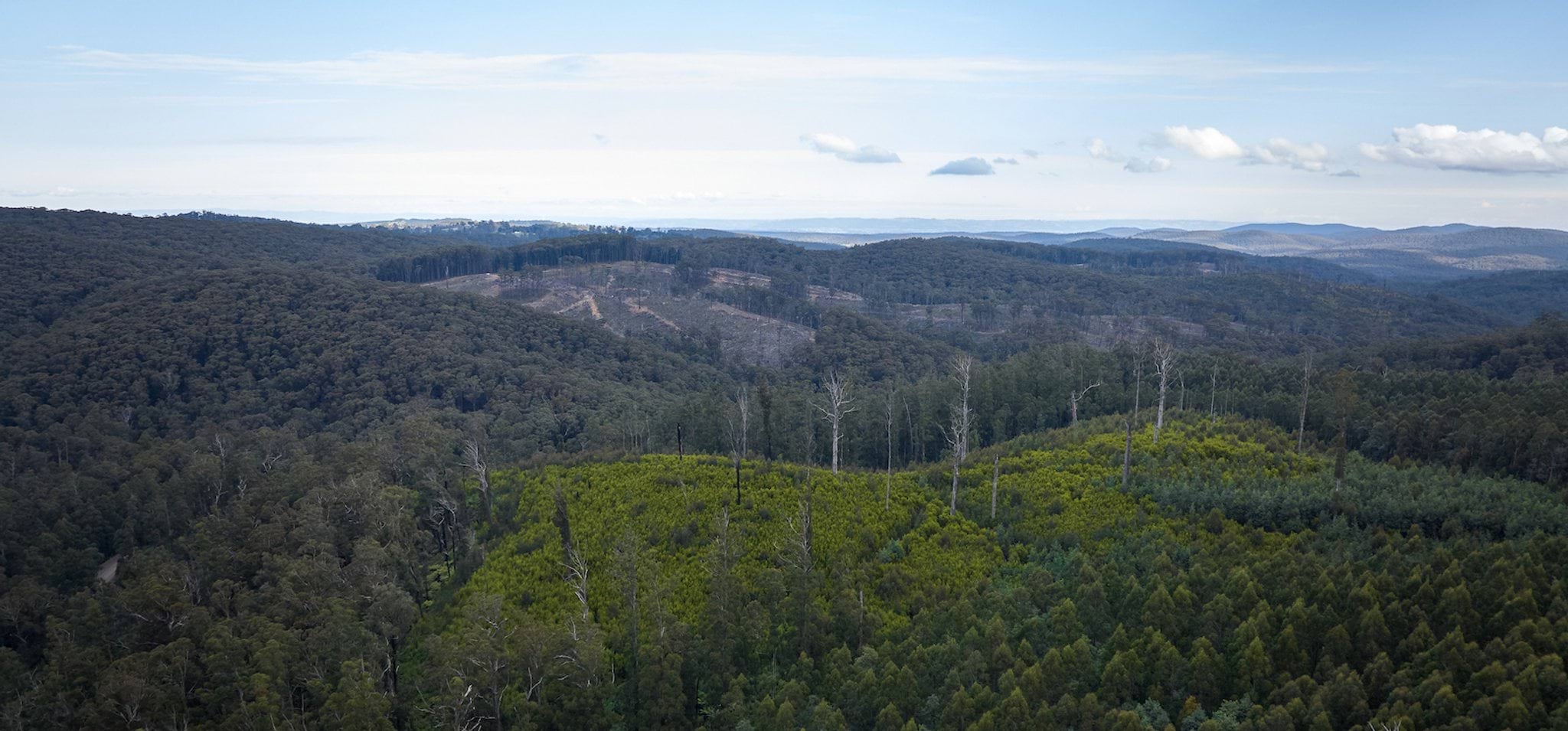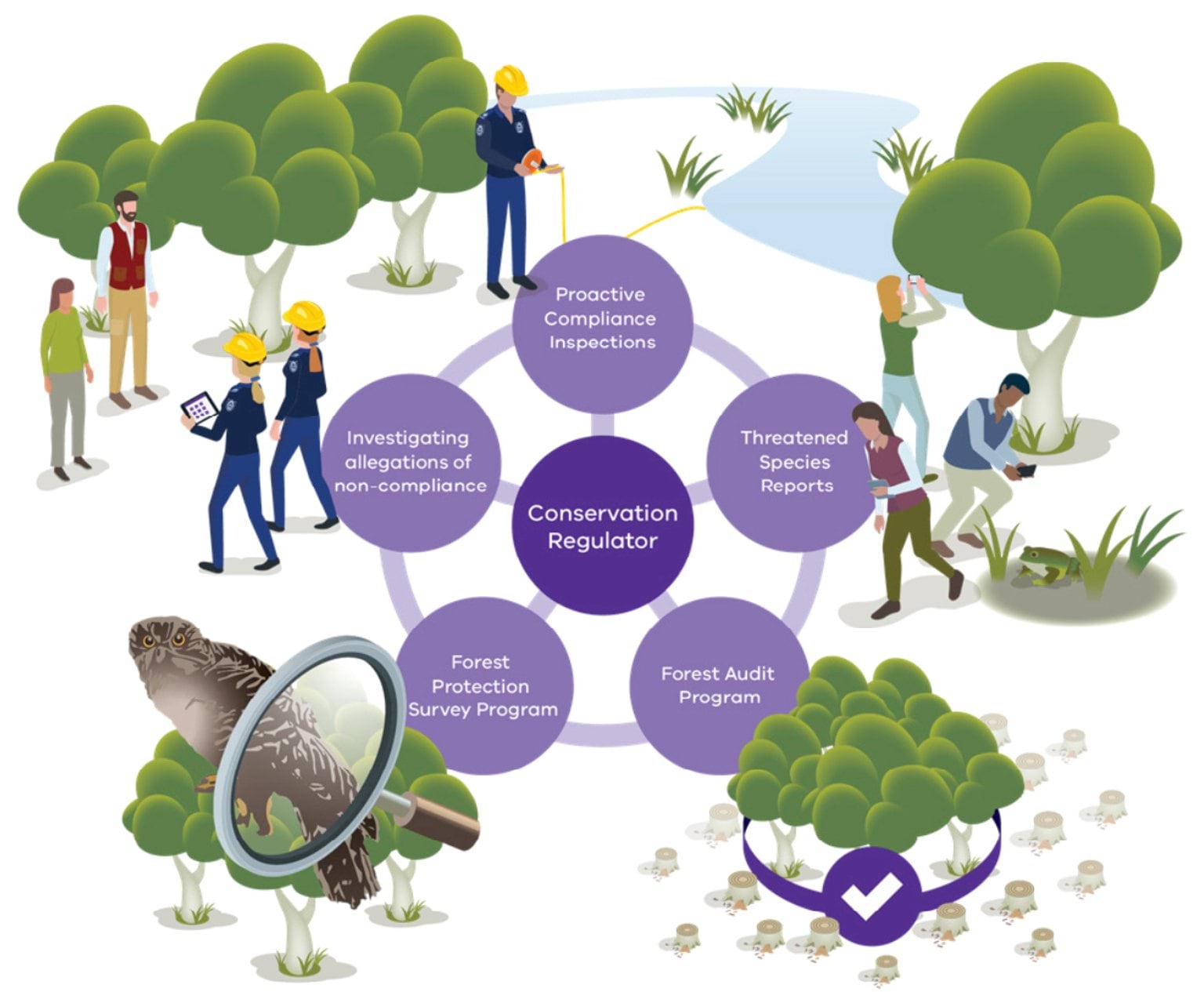The Conservation Regulator continued its focused effort on the regulation of timber harvesting in state forests, with an emphasis on proactive activities to prevent harm. Reactive compliance and enforcement efforts, particularly in response to reports of non-compliances and third-party information, also continues to be a significant focus.
A holistic approach to timber harvesting regulation
Figure 4 summarises how the Conservation Regulator works to ensure that the planning and conduct of timber harvesting operations complies with the law, and that important forest values are protected.
In 2021-22, we continued to be adaptive in our regulatory approach, using the best available information and intelligence to target our activities to those areas with potential for the greatest environmental harm.
Proactive coupe inspections
The proactive Coupe Inspection Program focuses on preventing environmental harm during timber harvesting. The coupes we inspect are selected based on the presence of important environmental values and high-risk activities. Information such as threatened species surveys, third-party reports, results from the Forest Audit Program and past observations by Conservation Regulator Authorised Officers are integral when prioritising coupes for inspection.
The Coupe Inspection Program includes assessments that are regionally distributed, examining a broad range of regulatory obligations and compliance across the ‘lifecycle’ of timber harvesting, from planning through to post-harvesting remediation.
In 2021-22, 53 coupes were proactively inspected, exceeding our financial year target of 30 coupes.
Reports of non‐compliance and threatened species detections
Members of the public can submit reports to the Conservation Regulator regarding allegations of non- compliant timber harvesting activities, the detection of threatened species or forest values found in or adjacent to planned timber harvesting locations.
Assessing each report is a priority for the Conservation Regulator and is undertaken by experienced Authorised Officers.
In 2021-22 we received 31 reports of alleged non- compliance and received 98 threatened species reports.
After reports of threatened species are made and while the necessary verification process is undertaken by relevant experts, Conservation Regulator ensures that interim protections (consistent with a positive verification) are established to protect important values from timber harvesting.
Across 2021-22, we processed and closed 63 threatened species reports. As of 30 June 2022, 40 threatened species reports were open while they are subject to verification or the implementation of changes to forest zoning.
During the year, three letters of advice, one formal written warning and three directions for remediation regarding timber harvesting activities were issued in relation to the conduct of VicForests and their contractors. In addition, one notice was issued to VicForests to suspend timber harvesting operations following failure to comply with a direction notice.
In response to feedback from stakeholders, we have also made a number of improvements to ensure transparent and clear information about our timber harvesting regulation activities including:
- A new online reporting tool for Forest Reports
- Publishing guidance on our website about what information, beyond the minimum requirements, can assist in progressing an assessment and investigation of a case.
- Providing clearer, more detailed case outcome information to those who submit a Forest Report, including detailed rationale and reasoning to better explain case outcome.
- Publishing improved information to our website about how the Conservation Regulator assesses a Forest Report, and the different factors that are considered in determining if a matter proceeds to the investigative phase.
- Establishing a Dispute Resolution process, which clearly outlines further avenues of enquiry should any stakeholder be dissatisfied with an outcome or wish to seek further information.
Forest Protection Survey Program
The Forest Protection Survey Program (FPSP) aims to detect threatened animals, plants and their habitats, as well as other high conservation values in State forest areas that are scheduled to be harvested. The FPSP is a highly adaptive program focused on State forests in the east of the state, and is constantly adapting and responding to the frequent and substantial changes in VicForests harvesting plans.
Detection of forest values results in their better protection from the impacts of timber harvesting, and in some cases can result in coupes not being harvested at all due to the large number of values that are detected.
In 2021-22, the program successfully achieved its annual target of surveying 80% of coupes planned for harvest, with 669 surveys conducted in 309 coupes planned for harvest in 2021-22, and in other coupes planned for harvest in future years.
Opportunities to engage the community in this program occurred through a series of online webinars delivered in late 2021, and via two open field days in April 2022 in the Tallarook and Yarra State Forests. The FPSP established three grants with Traditional Owner Corporations that resulted in direct participation by Traditional Owners in field surveys with FPSP contractors, and delivery of various cultural awareness training days, providing direct support for self-determination outcomes.
Making information publicly accessible is a key priority, and information on survey schedules and survey results is available via the Forest Information Portal, which is a publicly accessible interactive online mapping tool. In 2021-22, further information was made publicly available on the site including compliance reports, threatened species reports, and information on the Conservation Regulator’s Coupe Inspection Program, along with updates to timber harvesting history data.
Forest Audit Program
The Forest Audit Program (FAP) is undertaken by an independent auditor, and assesses the compliance of VicForests’ timber harvesting operations with the requirements outlined in the Code of Practice for Timber Production 2014 and the Management Standards and Procedures for Timber Harvesting Operations in Victoria’s State Forests 2014.
For the third year in a row, an independent environmental audit was undertaken to measure compliance of commercial timber harvesting operations, by auditing a representative sample of coupes harvesting in the 2021-22 financial year to assess a range of target themes.
The 2021-22 audit focused on:
- Protection of soil, water and biodiversity values
- Execution of in-coupe road design and construction
- Implementation of forest couple planning
- Compliance with measures under the precautionary principle. This includes a focus on the management of flora and fauna values in 2019-20 fire footprint within the East Gippsland FMA.
The outcomes of the 2021-22 FAP will be published during the 2022-23 financial year. Previous FAP outcomes are available on the Conservation Regulator website and demonstrate year-on-year improvements in VicForests’ compliance outcomes. This continued incremental improvement in compliance outcomes is, we believe, directly attributable to the Conservation Regulator’s more impactful regulatory engagement approach with VicForests and its contractors, contributing to the improved environmental performance of commercial timber harvesting and greater prevention of environmental harm.
Independent Review into Timber Harvesting Regulation
In 2018, at the request of the Minister for Energy, Environment and Climate Change (now Minister for Environment and Climate Action), an Independent Review into Timber Harvesting Regulation was undertaken. DELWP accepted all recommendations from the review in full and made further commitments to improve the way in which timber harvesting is regulated.
All commitments that the Conservation Regulator is responsible for delivering have been completed, and these are summarised in Appendix A.
Statement of Regulatory Intent for Timber Harvesting Regulation
In 2019, the Conservation Regulator released its Statement of Regulatory Intent for Timber Harvesting Regulation and committed to publicly reporting on an annual basis on the performance measures it contained. Table 2 below provides an update on each of the measures contained in the statement.
Table 2 Performance measure results for Timber Harvesting Compliance
|
Performance measure |
Target |
Result |
Comment |
|
Per cent of coupes planned for timber harvesting that have assessments under the FPSP for the potential presence of target flora and fauna, including threatened species and other values such as prescribed vegetation communities and trees. |
100% |
100% |
Target met |
|
Per cent of coupes planned for harvest that are surveyed |
80% |
81% |
Target met |
|
Per cent of coupes identified to contain rainforest as part of the FPSP that are spot checked |
20% |
N/A |
Checks of rainforest are now embedded within the Proactive Coupe Inspection Program, and it is an important value that is considered when selecting coupes for assessment |
|
Acknowledge receipt of reports of non-compliance |
<2 workdays |
1.6 work days |
Target met |
|
Commence the verification of threatened species reports |
<5 workdays |
0.81 work days |
Target met |
|
Number of coupes harvested in previous year that were audited as part of the FAP |
30 |
24 |
32 coupes were planned to be audited for the year, however, were delayed |
|
Number of coupes planned for timber harvesting, or where timber harvesting is underway, that are subject to compliance inspections |
30 |
53 |
Target met |
|
Average time taken to investigate alleged or suspected non-compliance |
<12 |
7.5 months |
Target met |
Table 3 Activity measures for timber harvesting related reports
|
Activity measure |
Result |
|
Number of threatened species reports received |
98 |
|
Number of threatened species reports that underwent verification |
32 |
|
Number of reports of alleged or suspected non-compliance received |
31 |
|
Number of reports of alleged or suspected non-compliance investigated |
5 |
Updated

